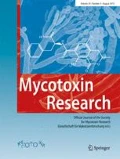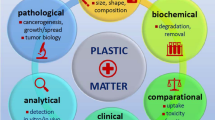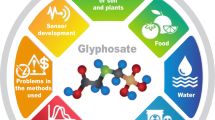Abstract
Mycotoxins’ exposure by inhalation and/or dermal contact can occur in different branches of industry especially where heavily dusty settings are present and the handling of dusty commodities is performed. This study aims to explore the possible contribution of the occupational exposure to aflatoxins by analysing urine samples for the presence of aflatoxins B1 and M1 and aflatoxin B1-N7-guanine adduct. The study was conducted in 2017 on two groups of volunteers, the workers group, composed by personnel employed in an Italian feed plant (n = 32), and a control group (n = 29), composed by the administrative employees of the same feed plant; a total of 120 urine samples were collected and analysed. A screening method and a quantitative method with high-resolution mass spectrometry determination were developed and fully validated. Limits of detections were 0.8 and 1.5 pg/mLurine for aflatoxin B1 and M1, respectively. No quantitative determination was possible for the adduct aflatoxin B1-N7-guanine. Aflatoxin B1 and its adduct were not detected in the analysed samples, and aflatoxin M1, instead, was found in 14 samples (12%) within the range 1.9–10.5 pg/mLurine. Only one sample showed a value above the limit of quantification (10.5 pg/mLurine). The absence of a statistical difference between the mean values for workers and the control group which were compared suggests that in this specific setting, no professional exposure occurs. Furthermore, considering the very low level of aflatoxin M1 in the collected urine samples, the contribution from the diet to the overall exposure is to be considered negligible.

Similar content being viewed by others
References
AOAC - Association of Official Agricultural Chemists (2005) Official methods of analysis of AOAC international, Ch.49.2.02 Method, 970.44
Battilani P, Toscano P, Van der Fels-Klerx HJ, Moretti A, Camardo Leggieri M, Brera C, Rortais A, Goumperis T, Robinson T (2016) Aflatoxin B1 contamination in maize in Europe increases due to climate change. Sci Rep 6:1–7. https://doi.org/10.1038/srep24328
Brera C, Caputi R, Miraglia M, Iavicoli I, Salerno A, Carelli G (2002) Exposure assessment to mycotoxins in workplaces: aflatoxins and ochratoxin a occurrence in airborne dusts and human sera. Microchem J 73:167–173
CAST - Council for Agricultural Science and Technology (2003) Mycotoxins: risks in plant, animal and human systems. Task force report No 139
Cramer B, Humpf H (2017) Human biomonitoring of mycotoxins for the detection of nutritional, environmental and occupational exposure. In: Viegas C, Viegas S, Gomes A, Täubel M, Sabino R (eds) Exposure to microbiological agents in indoor and occupational environments. Springer, Cham, pp 191–212. https://doi.org/10.1007/978-3-319-61688-9_9
Doi K, Uetsuka K (2014) Mechanisms of mycotoxin-induced dermal toxicity and tumorigenesis through oxidative stress-related pathways. J Toxicol Pathol 27:1–10. https://doi.org/10.1293/tox.2013-0062
EFSA – European Food Safety Authority (2010) management of left-censored data in dietary exposure assessment of chemical substances. EFSA J 8:1557. https://doi.org/10.2903/j.efsa.2010.1557
European Commission [EC] (2016) Guidance document on identification of mycotoxins in food and feed. SANTE/12089/2016. Available from: http://tinyurl.com/y86zckkj
FAO - Food and Agriculture Organization of the United Nations (2004) Worldwide regulations for mycotoxins in food and feed in 2003. FAO food and nutrition paper 81. Rome, Italy. Available from: http://www.fao.org/3/y5499e/y5499e00.htm#Contents
Ferri F, Brera C, De Santis B, Fedrizzi G, Bacci T, Bedogni L, Capanni S, Collini G, Crespi E, Debegnach F, Ferdenzi P, Gargano A, Gattei D, Luberto F, Magnani I, Magnani MG, Mancuso P, Menotta S, Mozzanica S, Olmi M, Ombrini G, Sala O, Soricelli S, Vicentini M, Giorgi Rossi P (2017) Survey on urinary levels of aflatoxins in professionally exposed workers. Toxins 9:117. https://doi.org/10.3390/toxins9040117
Ghosh SK, Desai MR, Pandya GL, Venkaiah K (1997) Airborne aflatoxin in the grain processing industries in India. Am Ind Hyg Assoc J 58:583–586
Giolo MP, de Oliveira CM, Bertolini DA, Campana Lonardoni MV, Gouveia MS, Pontes Netto D, Nixdorf SL, Machinski M (2012) Aflatoxin M1 in the urine of non-carriers and chronic carriers of hepatitis B virus in Maringa, Brazil. Braz J Pharm Sci 48:447–451. https://doi.org/10.1590/S1984-82502012000300011
Groopman JD (1994) Molecular dosimetry methods for assessing human aflatoxin exposures. In: Eaton DL, Groopman JD (eds) The toxicology of aflatoxins: human health, veterinary, and agricultural significance. Academic Press, San Diego, pp 259–280
Groopman JD, Wild CP, Hasler J, Junshi C, Wogan GN, Kensler TW (1993) Molecular epidemiology of aflatoxin exposures: validation of aflatoxin-N7-guanine levels in urine as a biomarker in experimental rat models and humans. Environ Health Perspect 99:107–113. https://doi.org/10.1289/ehp.9399107
International Agency for Research on Cancer [IARC] (1993) Some naturally occurring substances: food items and constituents, heterocyclic aromatic amines and mycotoxins, Vol. 56: IARC Monographs on the evaluation of the carcinogenic risks to humans, pp. 1–599. Available from: https://publications.iarc.fr/Book-And-Report-Series/Iarc-Monographs-On-The-Identification-Of-Carcinogenic-Hazards-To-Humans/Some-Naturally-Occurring-Substances-Food-Items-And-Constituents-Heterocyclic-Aromatic-Amines-And-Mycotoxins-1993
Malik A, Ali S, Shahid M, Bhargava R (2014) Occupational exposure to Aspergillus and aflatoxins among food-grain workers in India. Int J Occup Environ Health 20:189–193
McLaughlin JK, Malker HSR, Malker BK, Stone BJ, Ericsson JLE, Blot WJ, Weiner JA, Fraumeni JF (1987) Registry-based analysis of occupational risks for primary liver cancer in Sweden. Cancer Res 47:287–291
Olsen JH, Dragsted L, Autrup H (1988) Cancer risk and occupational exposure to aflatoxins in Denmark. Br J Cancer 58:392–396
Romero AC, Ferreira TRB, Dias CTS, Calori-Domingues MA, Gloria EM (2010) Occurrence of AFM1 in urine samples of a Brazilian population and association with food consumption. Food Control 21:554–558
Saad-Hussein A, Beshir S, Moubarz G, Elserougy S, Ibrahim MI (2013) Effect of exposure to aflatoxins on some liver tumor markers in textile workers. Am J Ind Med 56:818–824
Saad-Hussein A, Taha MM, Beshir S, Shahy EM, Shaheen W, Elhamshary M (2014) Carcinogenic effects of aflatoxin B1 among wheat handlers. Int J Occup Environ Health 20:215–219
Stein RA, Bulboaca AE (2017) Mycotoxins. In: Dodd C, Aldsworth T, Stein R (eds) Foodborne diseases, 3rd edn. Elsevier, San Diego, pp 407–446
Sulyok M, Berthiller F, Krska R, Schuhmacher R (2006) Development and validation of a liquid chromatography/tandem mass spectrometric method for the determination of 39 mycotoxins in wheat and maize. Rapid Commun Mass Spectrom 20:2649–2659. https://doi.org/10.1002/rcm.2640
Turner P, Flannery B, Isitt C, Ali M, Pestka J (2012) The role of biomarkers in evaluating human health concerns from fungal contaminants in food. Nutr Res Rev 25:162–179. https://doi.org/10.1017/S095442241200008X
Vidyasagar T, Sujatha N, Sashidhar RB (1997) Direct synthesis of aflatoxin B1-N7-guanine adduct: a reference standard for biological monitoring of dietary aflatoxin exposure in molecular epidemiological studies. Food Add Contam 14:457–467. https://doi.org/10.1080/02652039709374552
Viegas S, Veiga L, Figueiredo P, Almeida A, Carolino E, Viegas C (2014) Assessment of workers’ exposure to aflatoxin B1 in a Portuguese waste industry. Ann Occup Hyg 59:173–181. https://doi.org/10.1093/annhyg/meu082
Viegas S, Veiga L, Almeida A, dos Santos M, Carolino E, Viegas C (2016) Occupational exposure to aflatoxin B1 in a Portuguese poultry slaughterhouse. Ann Occup Hyg 60:176–183
Viegas S, Osteresch B, Hövelmann Y, Cebola de Oliveira A, Cramer B, Viegas C, Humpf HU (2017) Exposure to mycotoxins in cork industry – the importance of a multibiomarker approach. 10th international symposium on biological monitoring in occupational and environmental health. Naples, Italy
Viegas S, Viegas C, Oppliger A (2018) Occupational exposure to mycotoxins: current knowledge and prospects. Ann Work Expo Health 62:923–941. https://doi.org/10.1093/annweh/wxy070
Walton M, Egner P, Scholl PF, Walker J, Kensler TW, Groopman JD (2001) Liquid chromatography electrospray-mass spectrometry of urinary aflatoxin biomarkers: characterization and application to dosimetry and chemoprevention in rats. Chem Res Toxicol 14:919–926
Wenzl T, Haedrich J, Schaechtele A, Robouch P, Stroka J (2016) Guidance document on the estimation of LOD and LOQ for measurements in the field of contaminants in feed and food. EUR 28099, publications Office of the European Union, Luxembourg. https://doi.org/10.2787/8931
Wild CP, Turner PC (2002) The toxicology of aflatoxins as a basis for public health decisions. Mutagenesis 17:471–481. https://doi.org/10.1093/mutage/17.6.471
Acknowledgements
Sole responsibility lies with the author, and the authority is not responsible for any use that may be made of the information contained therein. Gabriele Moracci, Paola De Santis, Maria Cristina Barea Toscan and Giuliana Verrone (Istituto Superiore di Sanità) and Massimo Magnani (Servizio Prevenzione Sicurezza Ambienti di Lavoro) are acknowledged for their technical assistance.
Funding
This research was funded by EFSA: GP/EFSA/AFSCO/2017/05PERFORMANCE: International Conference “The Burden of Mycotoxins on animal and human health” and Research Project “Biomonitoring data as a tool for assessing aflatoxin B1 exposure of workers – BIODAF”.
Author information
Authors and Affiliations
Corresponding author
Ethics declarations
The study has been approved by the Ethical Committee of Reggio Emilia Province and performed in accordance with the ethical standards laid down in the 1964 Declaration of Helsinki and its later amendments.
Conflict of interest
The authors declare that they have no conflict of interest.
Additional information
Publisher’s note
Springer Nature remains neutral with regard to jurisdictional claims in published maps and institutional affiliations.
Rights and permissions
About this article
Cite this article
Debegnach, F., Brera, C., Mazzilli, G. et al. Optimization and validation of a LC-HRMS method for aflatoxins determination in urine samples. Mycotoxin Res 36, 257–266 (2020). https://doi.org/10.1007/s12550-020-00389-6
Received:
Revised:
Accepted:
Published:
Issue Date:
DOI: https://doi.org/10.1007/s12550-020-00389-6




